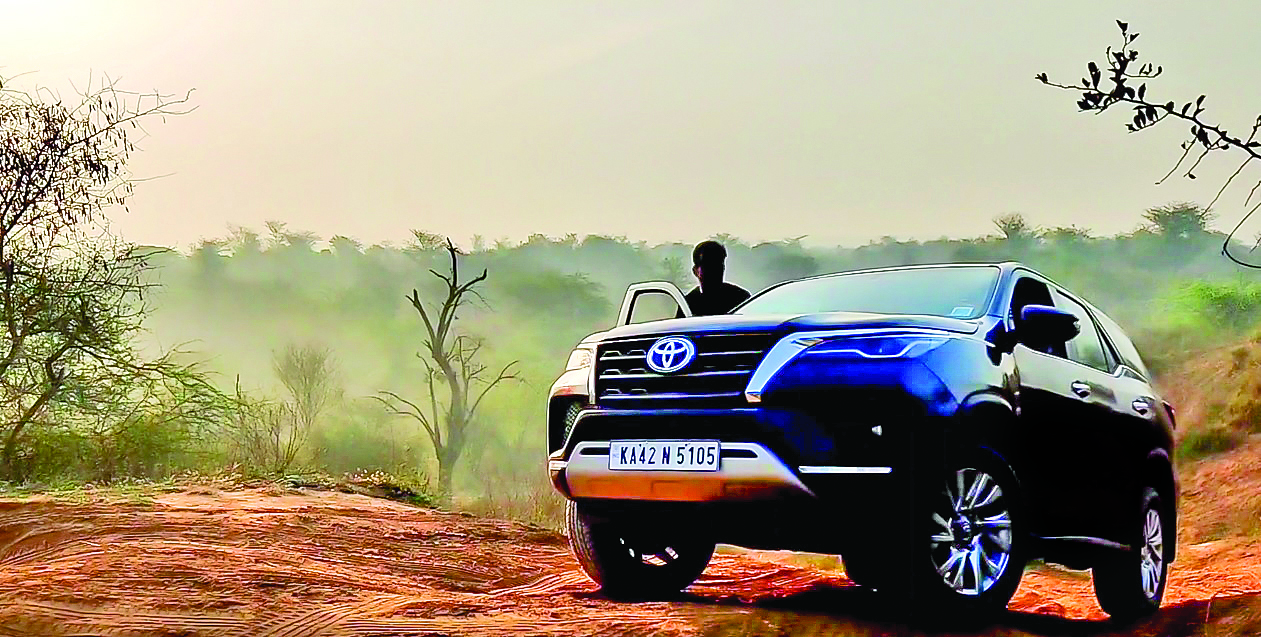
Does a 4×2 truck make any sense? Is it too expensive? Should you buy the “regular” Fortuner instead? We answer these questions, and more, in this review!
For almost 15 years now, the Toyota Fortuner has been the default choice for people in India who want a rugged and dependable SUV, and not without reason. It’s proven to be stronger and more reliable than most human relationships, and less demanding (read: “lowest-in-segment service costs”) than them too. However, it’s also perhaps the only vehicle in India that has seen the maximum increment in price over this period. It was launched in 2009 at around 20 lakh rupees on-road, and now, while buying the top-end GR-S will set you back by over 55 lakh rupees, the base variant itself would cost you a bit over 40 lakh rupees on road. Therefore, this review will tell you whether it still makes sense to buy one today, and also if you should even consider the Legender at all. I had tested the Fortuner 4×4 AT in 2022, and this time I had the Legender 4×2 AT with me for around a week. This is indeed supposed to be the latter’s review, but, as and when necessary, I would be mentioning the former as well to equip you with all the information you need to choose between the two.
Design & Presence
Other than reliability and low maintenance, the immense road presence of the Fortuner is the primary reason behind its popularity. However, while the Fortuner carries an aura of an uptight bouncer, the Legender seems to be that gentle giant in the gym who anyone can approach for help. If you ask me, I still like the Fortuner more because it’s not trying to please anyone. The Legender isn’t doing that either, but its kindness can sometimes be taken for granted on the road…
Interiors
The Legender was launched as the more premium version of the Fortuner, and while its exterior design might make a few feel that way, on the inside it’s almost the same as the Fortuner.
You may check the company’s website for the difference in features, if any, because I just couldn’t find any usable feature which the Legender has and the Fortuner doesn’t. The only major noticeable change is the maroon-and-black upholstery in the Legender, and here as well, I prefer the all-black interiors of the Fortuner. Of course, it’s absolutely okay if you like the maroon-and-black combination more.
Now, while no one in their right mind would refer to the Legender’s cabin as premium, there’s no denying the fact that just like the Fortuner’s, this one’s too is ergonomically perfect. Everything is within an easy reach, and there are proper physical buttons, knobs, dials, and switches for all major functions and features. Also, nothing is hidden—except the cruise control stalk, but you get used to it in no time—and you won’t need any YouTube tutorials to operate this vehicle or to understand how everything works inside the cabin.
I must also state that Toyota has my full support for not providing a sunroof. Please keep at it, Toyota. We need fantastic air-conditioning, and not sunroofs, in India. And I’m happy to report that the air-conditioning here is brilliant. I tested the Legender recently when we were experiencing all-time high temperatures in Delhi (we still are), and the Legender’s air-con worked flawlessly. Heat rejection glass and
ventilated front seats further help you in keeping your cool in the worst Indian summers.
The front and second row seats remain as comfortable as ever, while the third row is also good enough for the least loved members of your family.
Performance & Fuel Efficiency
Now we come to the best part of this vehicle. In the last 15 years, the Fortuner has seen a 3.0 L diesel, a 2.5 L diesel, and this, a 2.8 L diesel. There’s a Fortuner petrol as well, but right now, we’re talking diesels, and you’ll be pleased to know that the current engine is the most powerful diesel yet in the Fortuner/Legender. Yes, you will smoke a stock 3.0 L Fortuner at the lights. I achieved a sub-10-second 0–100 km/h (speedo) run, which makes this leviathan a frightening sight in the rear view mirrors of the much lighter 160 PS crossovers driven by red-light-jumping boy-racers.
Driven sanely, the Legender maintains a cruising speed of 100 km/h at just over 1,600 rpm, and 120 km/h at a shade below 1,800 rpm. You can cruise at these speeds all day, while also taking comfort in the knowledge that you still have an enormous reserve of power and torque for effortless overtaking maneuvers, even at these speeds. And that’s irrespective of the Drive Mode (Eco, Normal, Sport) you’re in. With over 200 horsepower, and 500 Nm of torque, you earn the privilege of leaving it in Eco or Normal, in the city and highways, and still fly past most other forms of traffic without much “planning.” In the hills, I’d keep it in Sport, with the gearshift lever also in Sport (Manual), and use the paddle shifters just to have more control. Okay, the honest reason would be—”just to have a bit more fun.”
However, if you don’t know what you’re doing, just leave it in Normal, with the gearshift lever in D, and the 6-Speed torque converter won’t disappoint.
Also, since it’s a body-on-frame truck, and not a unibody hot hatch, please treat it with respect around bends. Cornering at high speeds isn’t its forte; beating bad roads into submission is, which it does more mercilessly than, say, what parents’ “disciplining” their kids in the eighties looked like…
However, it must be said that the ride quality on good roads, especially with just the driver and a passenger, is always a touch bouncy, but that’s typical of most ladder-frame trucks. It gets better with a full load of passengers and luggage. I think it’s Toyota’s way of promoting family bonding, which is again an eighties’ value set…
The straight-line stability is good too, and the heavy steering adds to your confidence. The strong brakes (ventilated discs all around), coupled to the safety suite that comprises all sorts of acronyms (VSC, BA, ABS with EBD, etc.), make sure that you don’t have a heart-in-mouth situation during emergency braking maneuvers, but I wouldn’t recommend taking it for granted.
Fuel Efficiency
The Legender 4×2 is around 125 kilos lighter than the 4×4 model,.and though this difference doesn’t matter much in a vehicle weighing over two and a half tonnes, there’s no escaping the fact that any amount of weight reduction in your vehicle does help in adding some weight to your wallet…
And, yes, the Legender 4×2 is considerate. In the city, with the AC always on, sometimes at full blast, the fuel efficiency figure never went down to a single digit! It always remained above 10 km/l, and rose to 15 km/l on empty expressways when kept below 120 km/h. Therefore, you may expect the 80 liter fuel tank to give you a range of around 800 km in the city (with the low fuel light coming on at 700 km), and easily over a thousand km on the highways.
Miscellaneous
The headlights are nice, and so is the all-around visibility. However, it’s high time that Toyota gave a 360-degree camera in all the Fortuners and Legenders. Also, the JBL sound system should be made standard across all variants.
Verdict
The Legender 4×2 AT is around five and a half lakh rupees more expensive than the Fortuner 4×2 AT. Heck, it’s around 1.3 lakh rupees dearer than even the Fortuner 4×4 AT. Therefore, if you have to buy a 4×2 truck, the Fortuner 4×2 AT makes way more sense than the Legender 4×2 AT.
However, if you ask me, I’d recommend the Fortuner 4×4 AT. It’s as well-equipped as the Legender 4×2, and has the same on-road mannerisms too. But, off the road, it comes threateningly close to a vehicle that’s regarded as the best four-door offroader in the world (I’ve tested both). And that, ladies and gentlemen, more than justifies the price Toyota is asking for it in India.















